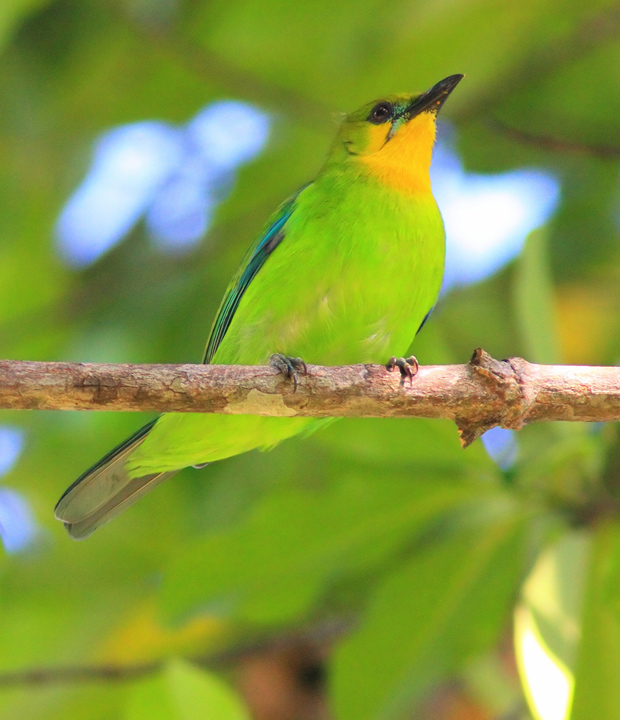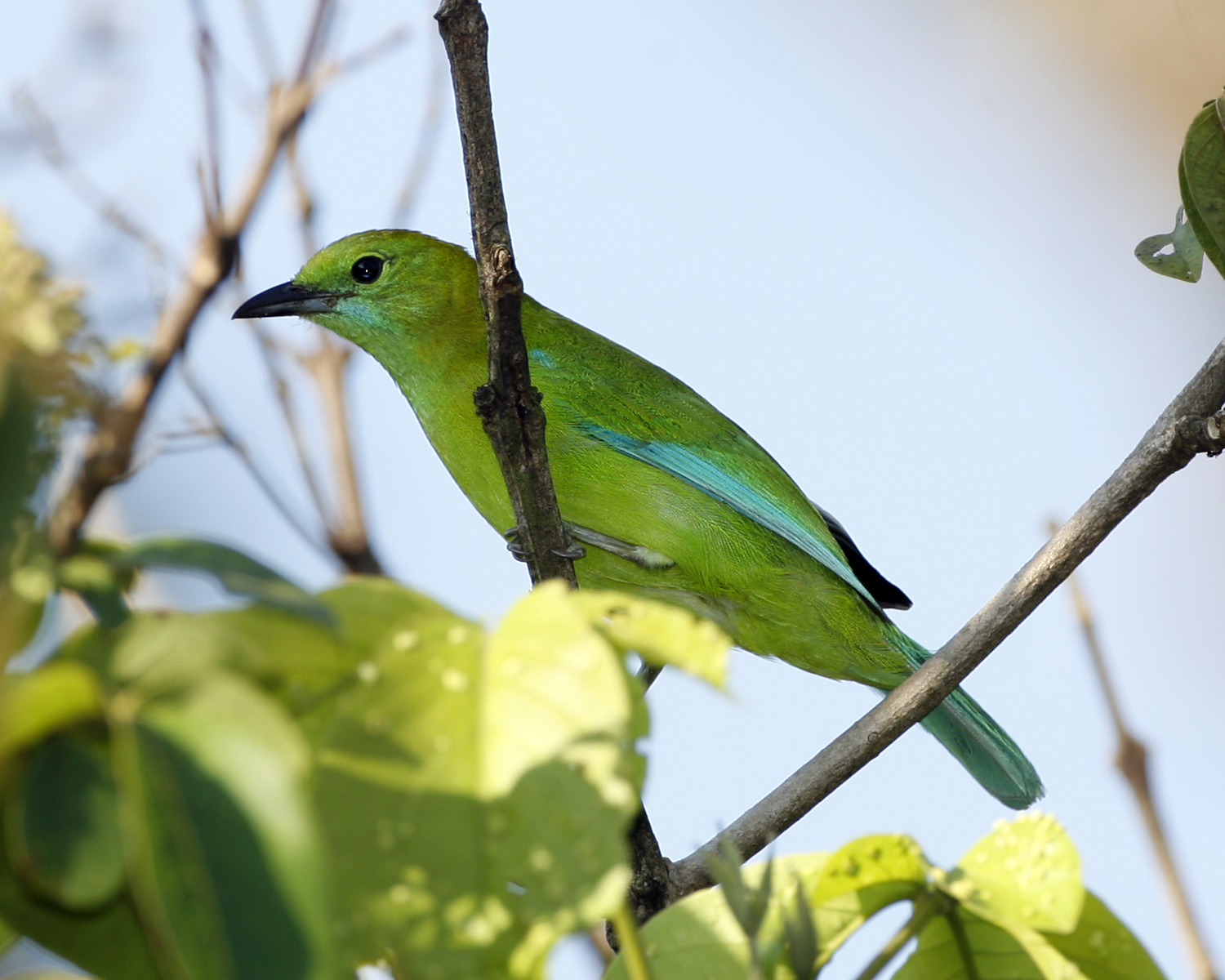Chloropsis on:
[Wikipedia]
[Google]
[Amazon]
 The leafbirds (Chloropseidae) are a family of small
The leafbirds (Chloropseidae) are a family of small
 Leafbirds usually feed in the
Leafbirds usually feed in the
 * Family: Chloropseidae
* Family: Chloropseidae
Leafbird videos
on the Internet Bird Collection {{Taxonbar, from=Q843381 01 Passeri Endemic birds of East Asia Taxa named by Sir William Jardine Taxa named by Prideaux John Selby
 The leafbirds (Chloropseidae) are a family of small
The leafbirds (Chloropseidae) are a family of small passerine
A passerine () is any bird of the order Passeriformes (; from Latin 'sparrow' and '-shaped'), which includes more than half of all bird species. Sometimes known as perching birds, passerines are distinguished from other orders of birds by th ...
bird
Birds are a group of warm-blooded vertebrates constituting the class Aves (), characterised by feathers, toothless beaked jaws, the laying of hard-shelled eggs, a high metabolic rate, a four-chambered heart, and a strong yet lightweig ...
species found in the Indian Subcontinent
The Indian subcontinent is a physiographical region in Southern Asia. It is situated on the Indian Plate, projecting southwards into the Indian Ocean from the Himalayas. Geopolitically, it includes the countries of Bangladesh, Bhutan, India ...
and Southeast Asia
Southeast Asia, also spelled South East Asia and South-East Asia, and also known as Southeastern Asia, South-eastern Asia or SEA, is the geographical United Nations geoscheme for Asia#South-eastern Asia, south-eastern region of Asia, consistin ...
. They were formerly grouped with the iora
: ''For the international organization, see Indian Ocean Rim Association''
: ''For the Australian Aboriginal people of the Sydney region, see Eora''
The ioras are a small family, Aegithinidae, of four passerine bird species found in south and so ...
s and fairy-bluebirds in the family Irenidae. As presently defined, the leafbird family is monogeneric, with all species placed in the genus
Genus ( plural genera ) is a taxonomic rank used in the biological classification of living and fossil organisms as well as viruses. In the hierarchy of biological classification, genus comes above species and below family. In binomial n ...
''Chloropsis''.
Description
The leafbirds range in size from , and in weight from . They resemblebulbul
The bulbuls are members of a family, Pycnonotidae, of medium-sized passerine songbirds, which also includes greenbuls, brownbuls, leafloves, and bristlebills. The family is distributed across most of Africa and into the Middle East, tropical ...
s, but whereas that group tends to be drab in colour, leafbirds are brightly plumaged, with the predominant green over the body giving rise to their common name. The family is mostly sexually dimorphic
Sexual dimorphism is the condition where the sexes of the same animal and/or plant species exhibit different morphological characteristics, particularly characteristics not directly involved in reproduction. The condition occurs in most ani ...
in their plumage, this can vary from the highly dimorphic orange-bellied leafbird to the Philippine leafbird, which exhibits no sexual dimorphism. Most of the differences between the sexes are in the extent of the other colours in the plumage, particularly in the colours around the head and the blue or black face mask, with females having less colour and a less extensive (or absent) mask. Some species have blue on the wings and tail. The plumage of juvenile birds is a duller version of the female's. To human ears, their songs
A song is a musical composition intended to be performed by the human voice. This is often done at distinct and fixed pitches (melodies) using patterns of sound and silence. Songs contain various forms, such as those including the repetiti ...
are melodious, and several species are good mimics. The calls include whistles and chatters.
Like bulbuls, leafbirds drop many body feathers when they are handled. This may confuse predators, especially snake
Snakes are elongated, limbless, carnivorous reptiles of the suborder Serpentes . Like all other squamates, snakes are ectothermic, amniote vertebrates covered in overlapping scales. Many species of snakes have skulls with several more j ...
s.
Distribution and habitat
Leafbirds are always found in trees and shrubs. Most are restricted to evergreen forests except thegolden-fronted leafbird
The golden-fronted leafbird (''Chloropsis aurifrons'') is a species of leafbird. It is found from the Indian subcontinent and south-western China, to south-east Asia and Sumatra.
It builds its nest in a tree, laying 2-3 eggs. This species eats ...
and Jerdon's leafbird which live in deciduous monsoon forests, and the orange-bellied leafbird, which occurs in deciduous forests. Within this requirement, they occupy all broadleaf forest types in the Indian Subcontinent and Southeast Asia. The highest altitude they occur at is 2500 m (8200 feet). Some species, such as the blue-masked leafbird, have montane distributions, rarely descending below 1000 m.
The orange-bellied leafbird and the golden-fronted leafbird are amongst the more widespread species, with large ranges across mainland Asia. Some species have more restricted distributions, such as the yellow-throated leafbird, which is endemic
Endemism is the state of a species being found in a single defined geographic location, such as an island, state, nation, country or other defined zone; organisms that are indigenous to a place are not endemic to it if they are also found els ...
to the Philippine island of Palawan
Palawan (), officially the Province of Palawan ( cyo, Probinsya i'ang Palawan; tl, Lalawigan ng Palawan), is an archipelagic province of the Philippines that is located in the region of Mimaropa. It is the largest province in the country in ...
, and the Bornean leafbird, restricted to northern Borneo. In general there are seldom more than three species occurring in the same area, although five species co-occur in the submontane forests of Sumatra. Co-occurring species are usually well-spaced on the spectrum of size, to reduce competition.
Behaviour
 Leafbirds usually feed in the
Leafbirds usually feed in the canopy
Canopy may refer to:
Plants
* Canopy (biology), aboveground portion of plant community or crop (including forests)
* Canopy (grape), aboveground portion of grapes
Religion and ceremonies
* Baldachin or canopy of state, typically placed over an ...
, eating insect
Insects (from Latin ') are pancrustacean hexapod invertebrates of the class Insecta. They are the largest group within the arthropod phylum. Insects have a chitinous exoskeleton, a three-part body (head, thorax and abdomen), three pairs ...
s and some fruit
In botany, a fruit is the seed-bearing structure in flowering plants that is formed from the ovary after flowering.
Fruits are the means by which flowering plants (also known as angiosperms) disseminate their seeds. Edible fruits in partic ...
and nectar. Prey is searched for by nimbly moving along the branch ends and gleaned. They are also capable of hover-gleaning to obtain prey, and will pursue flushed prey into the air or even as far as the forest floor. The extent to which the leafbirds consume nectar is a matter of some debate; records are more common in Southern Asia compared to South East Asia. Some species join mixed feeding flocks now and then; others defend the blooming and fruiting trees and bushes where they forage.
Unlike most tropical Asian passerines, the nests of leafbirds are not located low down in the forest, but are instead found on the ends of branches near the tree crown. As such the nests of many species have rarely, if ever, been seen. The nests are open cups; of the few known, they are built of fine stems, leaf parts and rootlets. Some hang from thin horizontal shoots of trees; in others the rim is attached to a pair of vertical twigs. Females lay 2 or 3 pinkish eggs
Humans and human ancestors have scavenged and eaten animal eggs for millions of years. Humans in Southeast Asia had domesticated chickens and harvested their eggs for food by 1,500 BCE. The most widely consumed eggs are those of fowl, especial ...
. The only information for incubation times comes from captive birds, and incubation lasts around 14 days. Incubation is apparently performed only by the female, although in at least two species the male feeds the incubating females.
Relationship with humans
Leafbirds are attractive birds and, combined with an attractive song and capacity to mimic sounds, they have become very popular cagebirds. The majority of the trade in this family is confined to Asia. Some populations have been locally depleted by the massive numbers captured for the trade. Overall the eleven species are mostly still common in suitable habitat, although the amount of suitable habitat has declined greatly with deforestation. Over half of leafbird species are either threatened or near threatened. The greater green leafbird, the blue-winged leafbird and theSumatran leafbird
The Sumatran leafbird (''Chloropsis media'') is a species of bird in the family Chloropseidae. It is endemic to forest and plantations in Sumatra in Indonesia. It has often been included as a subspecies of the golden-fronted leafbird (''C. aurif ...
are endangered
An endangered species is a species that is very likely to become extinct in the near future, either worldwide or in a particular political jurisdiction. Endangered species may be at risk due to factors such as habitat loss, poaching and inv ...
because of trapping for the cage bird trade. One species, the Philippine leafbird, is listed as vulnerable
Vulnerable may refer to:
General
* Vulnerability
* Vulnerability (computing)
* Vulnerable adult
* Vulnerable species
Music
Albums
* ''Vulnerable'' (Marvin Gaye album), 1997
* ''Vulnerable'' (Tricky album), 2003
* ''Vulnerable'' (The Used album) ...
due to habitat loss
Habitat destruction (also termed habitat loss and habitat reduction) is the process by which a natural habitat becomes incapable of supporting its native species. The organisms that previously inhabited the site are displaced or dead, thereby ...
. The lesser green leafbird and the blue-masked leafbird are listed as near threatened
A near-threatened species is a species which has been categorized as "Near Threatened" (NT) by the International Union for Conservation of Nature as that may be vulnerable to endangerment in the near future, but it does not currently qualify fo ...
.
Species
 * Family: Chloropseidae
* Family: Chloropseidae
References
External links
Leafbird videos
on the Internet Bird Collection {{Taxonbar, from=Q843381 01 Passeri Endemic birds of East Asia Taxa named by Sir William Jardine Taxa named by Prideaux John Selby